Santa Clara Exquisitely Carved Black Jar by Linda Tafoya-Sanchez - C4111C
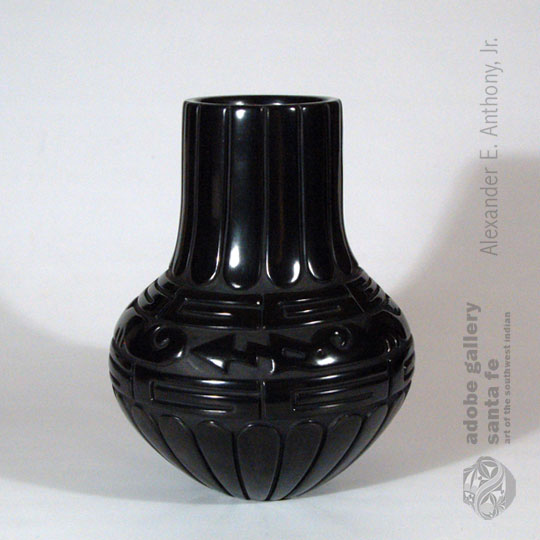 There isn't a square inch on this jar without design. Linda Tafoya-Sanchez divided the design concept into five different bands. Starting from the top of the vessel, the stove-pipe neck is filled with fourteen vertical and parallel polished bars, each separated by a thin matte line. The next panel of design consists of Greek-keyelements encircling the lower neck. On the shoulder is an Avanyu, or wtaer serpent,wrapped around to the point where the tail meets the mouth, from which a lightning bolt extends. At the midbody of the jar is a series of Greek-key elements. The final panel, below mid-body, is a series of feathers that extend to the base of the jar. Each of these designs is highly polished to perfection.
There isn't a square inch on this jar without design. Linda Tafoya-Sanchez divided the design concept into five different bands. Starting from the top of the vessel, the stove-pipe neck is filled with fourteen vertical and parallel polished bars, each separated by a thin matte line. The next panel of design consists of Greek-keyelements encircling the lower neck. On the shoulder is an Avanyu, or wtaer serpent,wrapped around to the point where the tail meets the mouth, from which a lightning bolt extends. At the midbody of the jar is a series of Greek-key elements. The final panel, below mid-body, is a series of feathers that extend to the base of the jar. Each of these designs is highly polished to perfection.
#adobegallery #SouthwestIndianPottery #SantaClaraPueblo #SantaClaraPottery #PuebloPottery #SouthwestIndianArt #SantaFePottery #FinePuebloPottery #ContemporaryPottery #sfim2018 #LindaTafoyaSanchez
Santa Clara Pueblo Large Red Carved Wedding Vessel by LuAnn Tafoya - C4111A
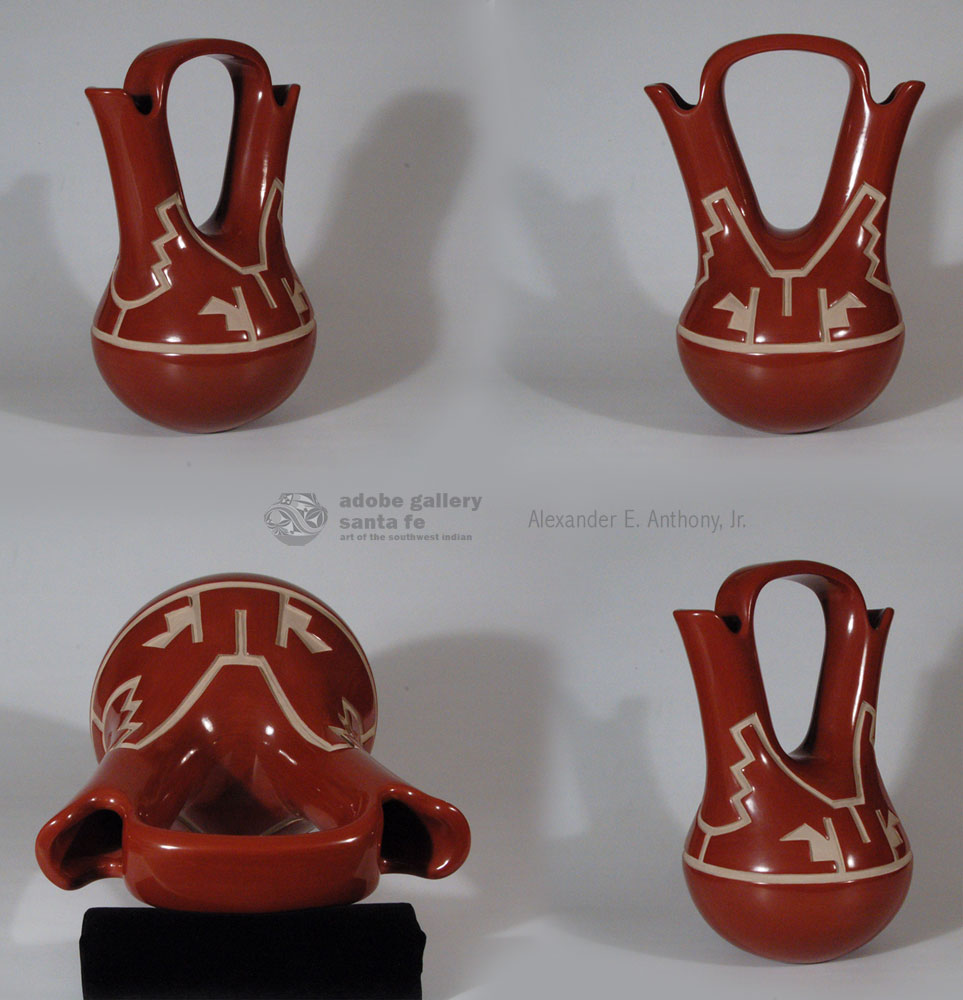 LuAnn Tafoya, a daughter of Margaret Tafoya, certainly inherited the talent to produce beautifully sculpted vessels with outrageously burnished surfaces. She has made jars almost three feet tall, a feat not easily accomplished. Her grandmother, Sara Fina Tafoya, was a masterful potter, as was her mother, Margaret, who, in turn, passed on this artistic gene and talent to nine children and numerous grandchildren.
LuAnn Tafoya, a daughter of Margaret Tafoya, certainly inherited the talent to produce beautifully sculpted vessels with outrageously burnished surfaces. She has made jars almost three feet tall, a feat not easily accomplished. Her grandmother, Sara Fina Tafoya, was a masterful potter, as was her mother, Margaret, who, in turn, passed on this artistic gene and talent to nine children and numerous grandchildren.
LuAnn has been a consistent award winner every year since 1980 and the ribbons keep coming in, deservedly. She is a master potter and has been recognized as such by judges and collectors. Her burnishing is unequal, forms are well balanced, and pottery designs executed to precision.
#adobegallery #SouthwestIndianPottery #SantaClaraPueblo #SantaClaraPottery #PuebloPottery #SouthwestIndianArt #SantaFePottery #FinePuebloPottery #ContemporaryPottery #sfim2018 #LuAnnTafoya
Original Painting “Moisture in the Morning Yei” by Pablita Velarde - C4105
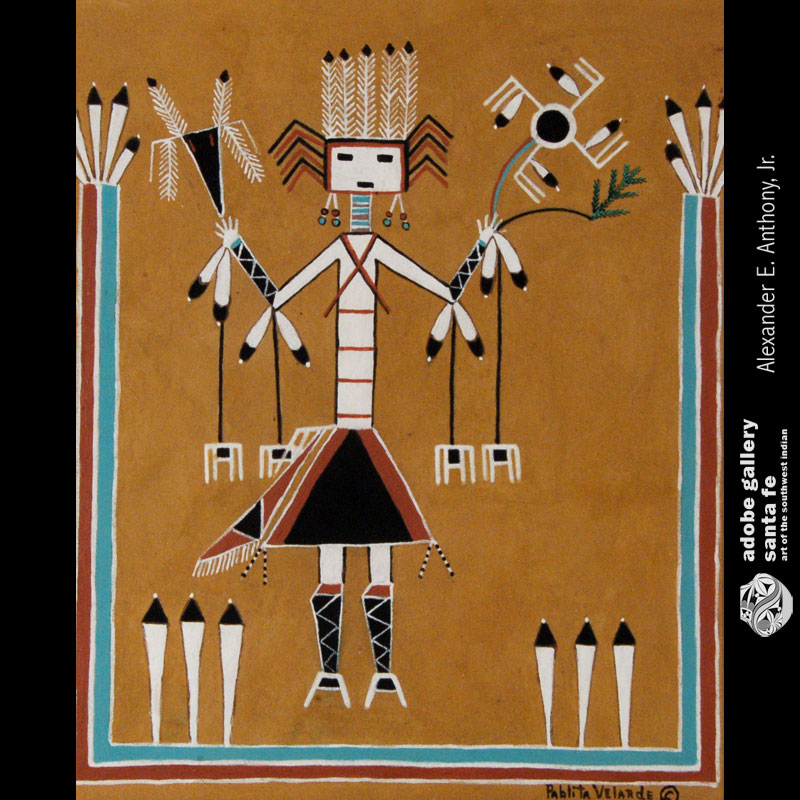 Pablita Velarde (1918-2006) Tse Tsan - Golden Dawn was an innovative and influential artist from Santa Clara Pueblo. Velarde was the first full-time female student in Dorothy Dunn's art class at the Santa Fe Indian School, where she studied alongside Tonita Peña. These two women are regarded as the first Native American women to support themselves as painters, but it's not just because of this that they are remembered so fondly. It's because of the quality of their works that they have remained so visible in the many years since they have passed.
Pablita Velarde (1918-2006) Tse Tsan - Golden Dawn was an innovative and influential artist from Santa Clara Pueblo. Velarde was the first full-time female student in Dorothy Dunn's art class at the Santa Fe Indian School, where she studied alongside Tonita Peña. These two women are regarded as the first Native American women to support themselves as painters, but it's not just because of this that they are remembered so fondly. It's because of the quality of their works that they have remained so visible in the many years since they have passed.
Velarde painted in the traditional style of the Santa Fe Indian School, creating accurate portraits of Native American life and culture. At first she worked in watercolor, but later learned how to prepare paints from natural pigments-a process called "Fresco Secco." She is best known for these mineral earth paintings. She ground mineral and rock elements on a metate and mano until the result was a powdery substance. From this substance her paints were made. She also painted on paper, often using casein in addition to earth pigments. She was also known to create art derived from the Navajo sandpainting tradition.
Velarde's list of accomplishments and accolades is long and varied. Her works have been exhibited around the country and are included in many prestigious public and private collections. Author and anthropologist Clara Lee Tanner called her the "greatest woman artist in the Southwest." Her daughter Helen Hardin and her granddaughter Margaret Bagshaw were themselves very successful and influential painters, creating an artistic dynasty that spanned three generations.
#adobegallery #SouthwestIndianPainting #NativeAmericanPainting #SantaclaraPainting #PablitaVelarde #FineArt #IndianMarketCountdown2018 #sfim2018
Ohkay Owingeh (San Juan) Pueblo Large Bowl with Red Rim - C4068Y
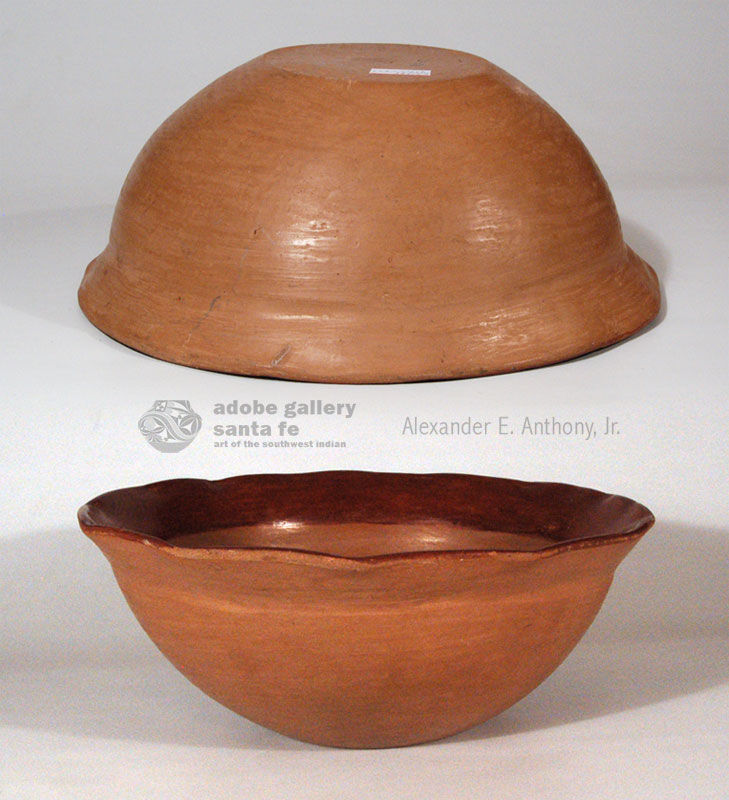 The beauty of Ohkay Owingeh pottery is its simplicity. The shape of the vessel is the dominant visual stimulation, not being overrun by painted design. The deep red slip that overlays the tan clay is traditional to all earlier bowls and jars. When the stone-polished vessel is fired in the traditional manner, there are usually beautiful fire clouds on the vessel wall, however, this bowl does not have fire clouds.
The beauty of Ohkay Owingeh pottery is its simplicity. The shape of the vessel is the dominant visual stimulation, not being overrun by painted design. The deep red slip that overlays the tan clay is traditional to all earlier bowls and jars. When the stone-polished vessel is fired in the traditional manner, there are usually beautiful fire clouds on the vessel wall, however, this bowl does not have fire clouds.
According to Batkin¹, pottery making at San Juan (Ohkay Owingeh) Pueblo almost died out by 1900 except for an occasional piece made for household use or for sale or trade. There was a revival in the 1930s but it was of a different style.
This bowl possibly dates to the early twentieth century but the lack of fire clouds and lack of indications of use would make one think it was made later and was made for sale, not for use at the pueblo.
#adobegallery #SouthwestIndianPottery # OhkayOwingehPueblo #OhkayOwingehPottery #PuebloPottery #SouthwestIndianArt #FinePuebloPottery #HistoricPottery #IndianMarket #sfim2018 #NativeAmericanArts
San Ildefonso Pueblo Black Design on Red and White Bowl - C4068X
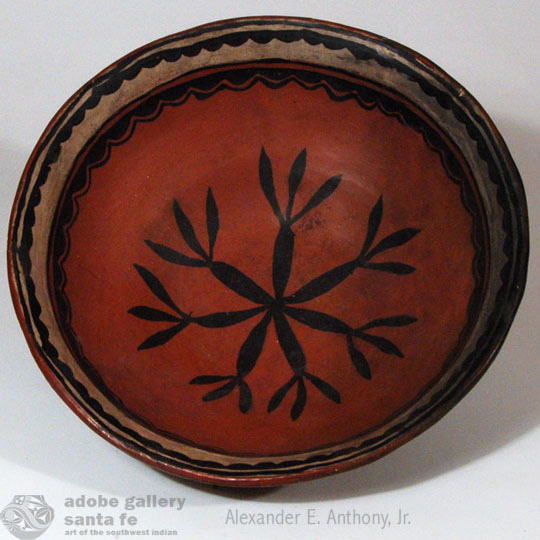 This is a most unusual bowl from San Ildefonso Pueblo. The interior was slipped in red, the interior rim was slipped in white, and the design was executed in black. This combination of design and color was used by Maria Martinez on occasion.
This is a most unusual bowl from San Ildefonso Pueblo. The interior was slipped in red, the interior rim was slipped in white, and the design was executed in black. This combination of design and color was used by Maria Martinez on occasion.
There are two vessels by Maria Martinez in the Museum of New Mexico collection (18798/12 and 36005/12), one of which is signed with her name Poh've'ka. In the first one, a jar, the upper neck-the full area above the shoulder-is decorated with Black-on-red, and the lower portion- the body of the vessel-is decorated in polychrome colors on white slip. The other vessel mentioned is a terrace rim bowl, with the exterior in black on red and the interior in traditional San Ildefonso Polychrome, both vessels being dated circa 1925.
It is not our intention to state or infer that this bowl was made by Maria and painted by Julian, only that they are known for having done similar styles.
#adobegallery #SouthwestIndianPottery #SanIldefonsoPueblo #SanIldefonsoPottery #PuebloPottery #SouthwestIndianArt #FinePuebloPottery #HistoricPottery #IndianMarket #sfim2018 #NativeAmericanArts
Historic Tesuque Pueblo Serving Bowl - C4068V
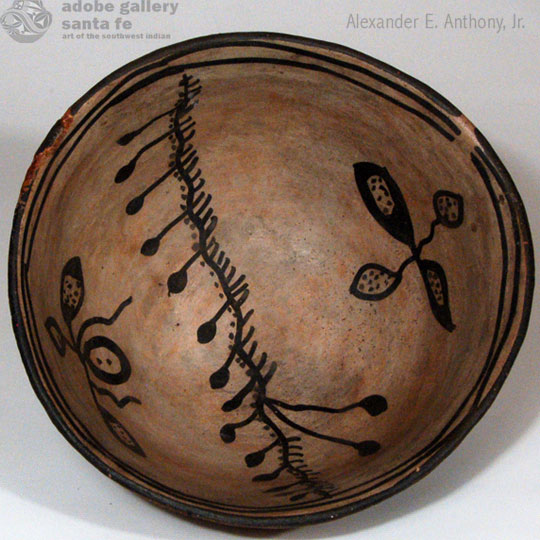 This circa 1880s bowl from Tesuque Pueblo appears never to have been used. The interior slip and design are in original condition. The bowl is a little out of alignment in roundness, varying in diameter by 1/4-inch. The depth is 4-½ inches on one area and 4 inches on another. It appears to have sagged while the clay was still moist or wet. It is those aspects of the bowl that add to its charm.
This circa 1880s bowl from Tesuque Pueblo appears never to have been used. The interior slip and design are in original condition. The bowl is a little out of alignment in roundness, varying in diameter by 1/4-inch. The depth is 4-½ inches on one area and 4 inches on another. It appears to have sagged while the clay was still moist or wet. It is those aspects of the bowl that add to its charm.
The double framing line on the interior of the bowl was most definitely placed free-hand as it is somewhat wavy in style. The designs on the interior were well executed. A two-inch wide red band was added to the rim area on the exterior of the bowl.
#adobegallery #SouthwestIndianPottery # TesuquePueblo # TesuquePottery #PuebloPottery #SouthwestIndianArt #FinePuebloPottery #HistoricPottery #IndianMarket #sfim2018 #NativeAmericanArts
Historic Zuni Pueblo Small White on Red Olla - C4068N
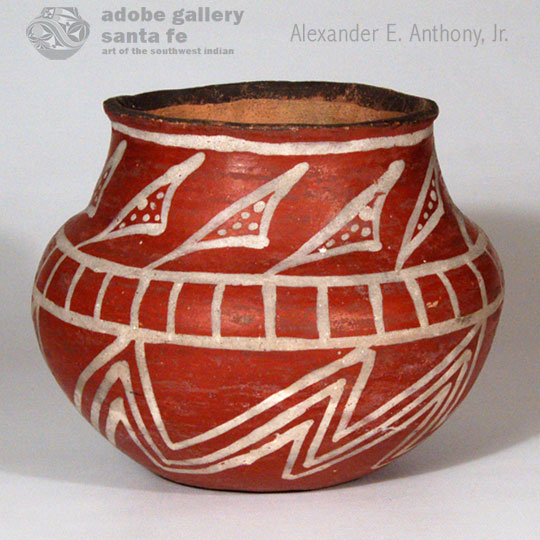 According to published information, Zuni potters experimented with putting red slip on pottery, rather than the standard cream slip, and painting the design with white slip, rather than the black normally used on Zuni Polychrome wares. This anomaly existed during the period designated as Zuni Polychrome, however, it was short-lived, lasting only from 1890 to 1920.
According to published information, Zuni potters experimented with putting red slip on pottery, rather than the standard cream slip, and painting the design with white slip, rather than the black normally used on Zuni Polychrome wares. This anomaly existed during the period designated as Zuni Polychrome, however, it was short-lived, lasting only from 1890 to 1920.
There is no published information stating why the White-on-red period ended in the 1920s. Speculation is that the newly-arrived trader at Zuni, C. G. Wallace, perhaps discouraged production of White-on-red in favor of the potters sticking to the traditional Zuni Polychrome style because he believed Polychrome wares would sell better. He was the primary, if not the sole, outlet for Zuni wares in the 1920s.
This White-on-red jar is smaller than others we have had in the past and those we currently have on our site, which makes it quite unique. The white slip was expertly applied in a thick coat on an equally thick coat of red slip. There is no weakness in the application. The red slip extends to the bottom of the vessel, Normally, Zuni jars have a brown lower body but not when jars are slipped in red. The rim is dark brown, the only brown on the jar.
#adobegallery #SouthwestIndianPottery #ZuniPueblo #ZuniPottery #PuebloPottery #SouthwestIndianArt #FinePuebloPottery #HistoricPottery #IndianMarket #sfim2018 #NativeAmericanArts
RARE Large Cochiti Pueblo Dough Bowl - 25521
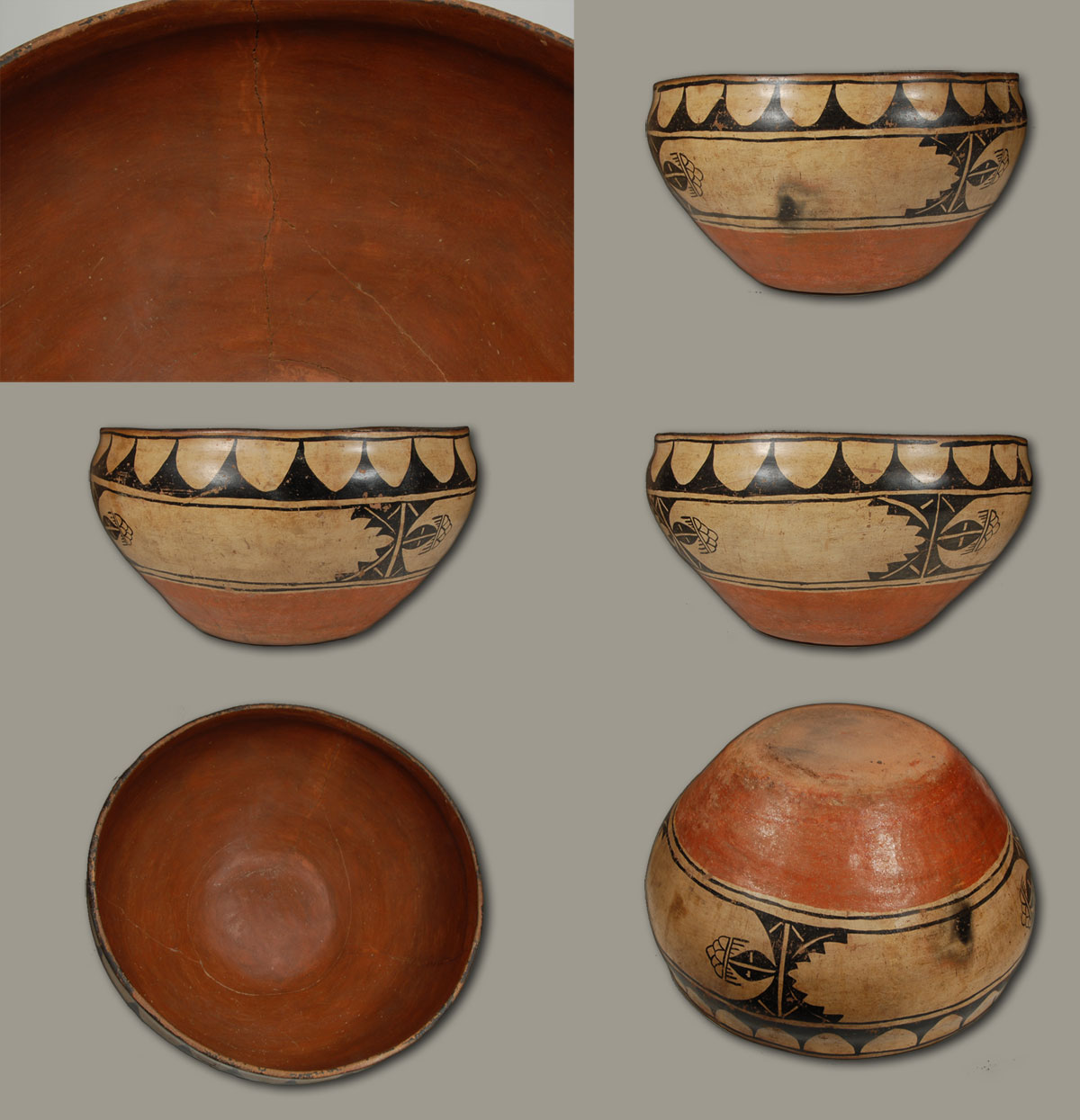 Cochiti Pueblo made very little utilitarian pottery after the 1880s because of the large demand for figurative pottery. Cochiti was the premier pueblo for making large figurines and there was a market for them, primarily by collectors, as museums thought them non-traditional and not worth putting in their collections.
Cochiti Pueblo made very little utilitarian pottery after the 1880s because of the large demand for figurative pottery. Cochiti was the premier pueblo for making large figurines and there was a market for them, primarily by collectors, as museums thought them non-traditional and not worth putting in their collections.
A large dough bowl such as this one is relatively rare from Cochiti. Many Cochiti families purchased dough bowls and large storage vessels from Santo Domingo neighbors. This dough bowl was made by Reyes Romero, according to members of her family. Apparently she was making bread in 1960 and sat the bowl on a chair. As the dough rose the bowl fell to the floor and broke. A gentleman from Tucson, Arizona, purchased the broken bowl from the family and we purchased the re-assembled bowl from him.
This bowl's designs are subtle and sparse. The main design, which includes an interesting sideways rain cloud pattern, is repeated four times around the bowl's exterior. Its patina is beautiful, and its size is impressive. The repairs are visible on the bowl's interior, but are fortunately invisinle on its exterior.
#adobegallery #SouthwestIndianPottery #cochitiPueblo #CochitiPottery #PuebloPottery #SouthwestIndianArt #FinePuebloPottery #HistoricPottery #IndianMarket #sfim2018 #NativeAmericanArts
Santo Domingo Pueblo 19th Century Dough Bowl - 16876
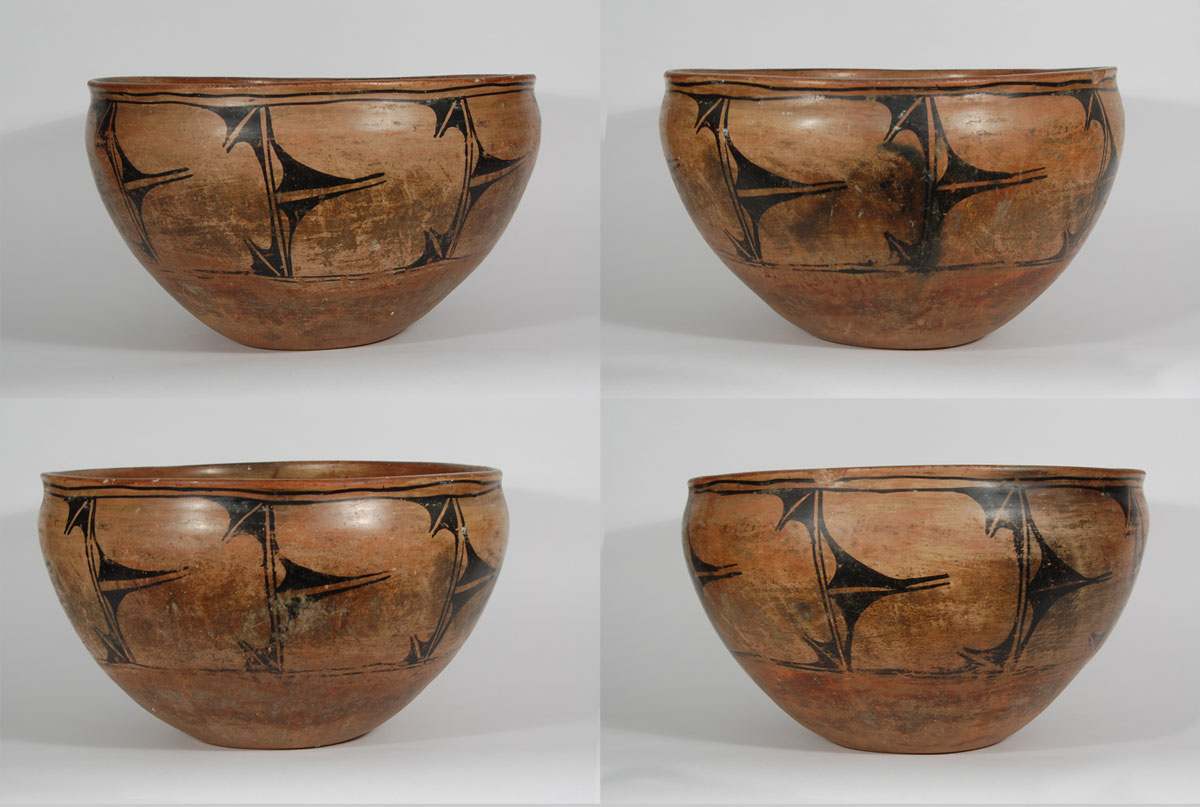 According to Jonathan Batkin (1987), the Smithsonian Institution collected very little pottery from Kewa Pueblo in 1879 and 1880, an indication that potters were making what they needed for daily use and not producing for sale to merchants or collectors. This situation changed in 1880 when a railroad stop was built near the pueblo and potters then began making pottery for sale. (That trading post at the railroad stop burned down and was closed a number of years ago but has just recently, in 2015, been restored and re-opened.) Pottery being made for use at the pueblo and pottery made for sale in the 1880s was of the highest quality and this persisted until around 1920.
According to Jonathan Batkin (1987), the Smithsonian Institution collected very little pottery from Kewa Pueblo in 1879 and 1880, an indication that potters were making what they needed for daily use and not producing for sale to merchants or collectors. This situation changed in 1880 when a railroad stop was built near the pueblo and potters then began making pottery for sale. (That trading post at the railroad stop burned down and was closed a number of years ago but has just recently, in 2015, been restored and re-opened.) Pottery being made for use at the pueblo and pottery made for sale in the 1880s was of the highest quality and this persisted until around 1920.
This Kewa Pueblo polychrome dough bowl dates to the 1880s or 1890s. It has the traditional rag-wiped bentonite slip, black rim around the top, and paired black framing lines above and below the decorated panels. The main body is decorated with sparsely spaced black cloud elements that frame otherwise large areas of undecorated expanse. The undecorated areas appear to be the focal point of the decoration from the manner in which the black designs frame them. Its fire clouds (natural decoration during the firing process when the fuel falls against the vessel and creates a dark area) are soft and beautiful. Fire clouds are a natural decoration during the firing process when the fuel falls against the vessel and creates a dark area.
#adobegallery #SouthwestIndianPottery #KewaPueblo #KewaPottery #PuebloPottery #SouthwestIndianArt #FinePuebloPottery #HistoricPottery #IndianMarket #sfim2018 #NativeAmericanArts
Zuni Pueblo Bola Tie of an Antelope or Deer Image - C4109F
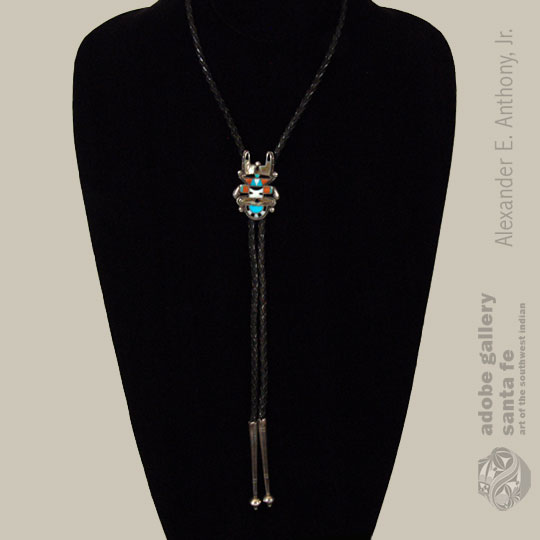 It is well established that Zuni Pueblo lapidary artisans are amazingly creative in making pictotrial jewelry in mosaic style. This bola features the head of an antelope or possibly a deer. The antlers were made from mother of pearl and tipped with jet. The animal's face was made from white shell and jet, ears of spondylus shell, and crown of white shell, turquoise and spondylus shell in triangular cuts. The mother of pearl neck ruff is in raised form, a trait started years ago by Zuni jeweler Leo Poblano. This is an incredible image that was beautifully and expertly created in the 1940s.
It is well established that Zuni Pueblo lapidary artisans are amazingly creative in making pictotrial jewelry in mosaic style. This bola features the head of an antelope or possibly a deer. The antlers were made from mother of pearl and tipped with jet. The animal's face was made from white shell and jet, ears of spondylus shell, and crown of white shell, turquoise and spondylus shell in triangular cuts. The mother of pearl neck ruff is in raised form, a trait started years ago by Zuni jeweler Leo Poblano. This is an incredible image that was beautifully and expertly created in the 1940s.
#adobegallery #SouthwestIndianJewelry #NativeAmericanJewelry #zuniJewelry #ZuniPueblo #Silver #Turquoise #sfim2018 #IndianMarket2018
Zuni Pueblo Magnificent Multi Stone Inlay Thunderbird Bola Tie - C4109E
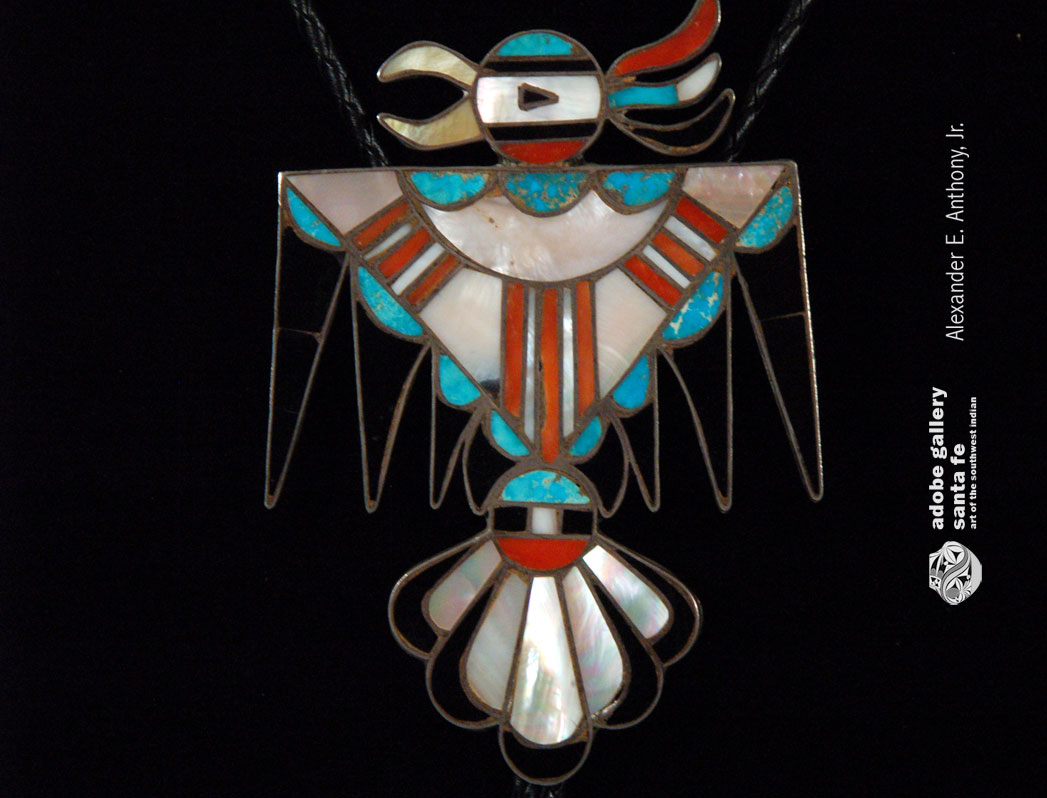 The Zuni are masters at lapidary work. The manner in which a lapidary artisan cuts a variety of stones and fits them together to form wonderful geometric patterns or figural elements is unequalled by any other jewelry-making tribes. The precise manner in which each stone is shaped is akin to an artist creating a painting-it is mosaic work of the finest quality.
The Zuni are masters at lapidary work. The manner in which a lapidary artisan cuts a variety of stones and fits them together to form wonderful geometric patterns or figural elements is unequalled by any other jewelry-making tribes. The precise manner in which each stone is shaped is akin to an artist creating a painting-it is mosaic work of the finest quality.
This mid-twentieth century Zuni Pueblo masterpiece features the legendary thunderbird. It was executed with turquoise, mother of pearl, coral (maybe spondylus), and jet, each cut in a variety of shapes from half moon, rectangular, trapezoidal, triangular and free form. It must have been a nightmare for the lapidary artisan who labored over it. The silver tips each have mosaic inlay feathers that are pendant and swing freely.
This is a spectacularly strong image that was beautifully created in the 1940s or 1950s.
#adobegallery #SouthwestIndianJewelry #NativeAmericanJewelry #zuniJewelry #ZuniPueblo #Silver #Turquoise #IMSF2018
Santa Clara Pueblo Polished Black Melon Jar by Angela Baca - C4107A
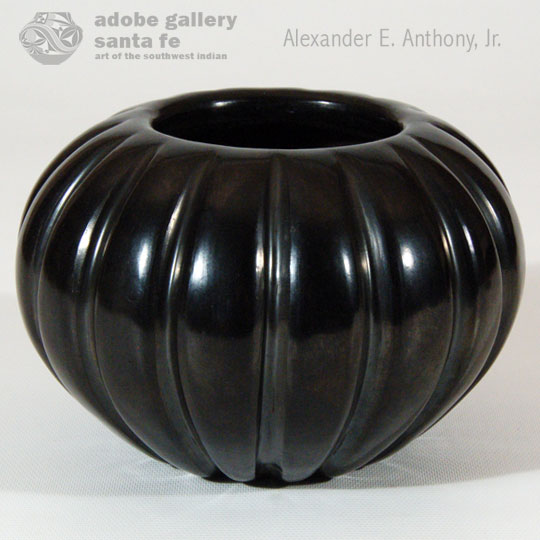 Angela Baca is most likely represented in every collection of contemporary pottery with one of her black melon jars, the style and shape that has been associated with her since the 1960s. She was probably the first potter to produce melon jars. I recall that the very first purchase I made at The Covered Wagon in Albuquerque in the 1960s was a black melon jar by Angela Baca at a price of $35. I was so impressed when I saw it that I put it on lay-away immediately.
Angela Baca is most likely represented in every collection of contemporary pottery with one of her black melon jars, the style and shape that has been associated with her since the 1960s. She was probably the first potter to produce melon jars. I recall that the very first purchase I made at The Covered Wagon in Albuquerque in the 1960s was a black melon jar by Angela Baca at a price of $35. I was so impressed when I saw it that I put it on lay-away immediately.
Others must have thought like me because Angela's pottery received awards at Santa Fe Indian Marketevery year she entered for competition. She also was awarded Best of Show at the Heard Museumand was presented with a Special Award by the French government. Her pottery was included in an exhibit of pottery by Maria and Julian Martinez in 1984 at a gallery in New Jersey and included in an exhibit of pottery by Margaret Tafoya at Sid Deusch Gallery in New York in 1985.
This jar has 16 ribs that run vertically from the rim to the base. The depressions between ribs were stone polished as well. It probably dates to the last quarter of the twentieth century. It is signed Angela Baca Santa Clara on the underside.
#adobegallery #SouthwestIndianPottery #SantaClaraPueblo #SantaClaraPottery #PuebloPottery #SouthwestIndianArt #SantaFePottery #FinePuebloPottery #ContemporaryPottery #IMSF2018 #AngelaBaca #NativeAmericanArts
Painting of a San Ildefonso Pueblo Dance by Tonita Peña - C4084i
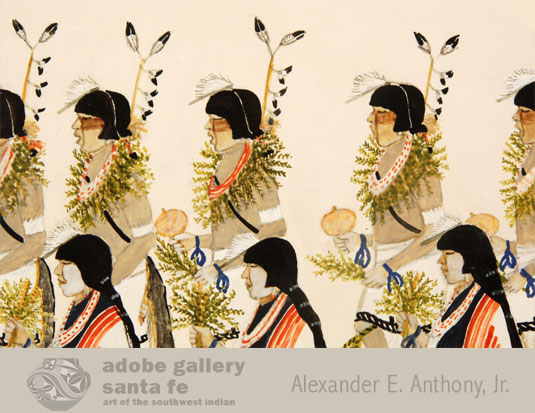 Tonita Peña (1893-1949) Quah Ah was born in 1893 at the small New Mexico pueblo of San Ildefonso. The pueblo is located on the Rio Grande, just north of Santa Fe. When Peña was just twelve years old, her mother passed away. Her father, unable to raise her while tending to his responsibilities at the pueblo, took her to live with her aunt and uncle at Cochiti Pueblo. This was where she would spend the remainder of her life. Peña was the only woman in the group of talented early pueblo artists referred to as the "San Ildefonso Self-Taught Group," which included such noted artists as Julian Martinez, Alfonso Roybal, Abel Sanchez, Crecencio Martinez, and Encarnación Peña. These artists were the earliest known pueblo painters. Today, their works are highly collectible not just because of their historical significance but because of their quality.
Tonita Peña (1893-1949) Quah Ah was born in 1893 at the small New Mexico pueblo of San Ildefonso. The pueblo is located on the Rio Grande, just north of Santa Fe. When Peña was just twelve years old, her mother passed away. Her father, unable to raise her while tending to his responsibilities at the pueblo, took her to live with her aunt and uncle at Cochiti Pueblo. This was where she would spend the remainder of her life. Peña was the only woman in the group of talented early pueblo artists referred to as the "San Ildefonso Self-Taught Group," which included such noted artists as Julian Martinez, Alfonso Roybal, Abel Sanchez, Crecencio Martinez, and Encarnación Peña. These artists were the earliest known pueblo painters. Today, their works are highly collectible not just because of their historical significance but because of their quality.
Peña is recognized as the first Pueblo Indian woman to make a living as a painter. By the time she was 25 years old, she was a successful easel artist. Her work was being displayed in museum exhibitions and in commercial art galleries in Santa Fe and Albuquerque. She painted what she knew best-scenes of life at the pueblo. She mostly painted ceremonial dances, and occasionally depicted everyday events. She did so with incredible skill and sensitivity. It is apparent in her works that she truly knew and respected each of the rituals she depicted. In the years since her passing she has come to be regarded as one of the greatest Indian artists of all time. Her works are displayed in prominent public and private collections around the country.
#adobegallery #SouthwestIndianPainting #NativeAmericanPainting #SanIldefonsoPainting #TonitaPena #FineArt #IndianMarketCountdown2018 #NativeAmericanArts
San Ildefonso Pueblo Painting of an Eagle Dance by Tonita Peña - C4084G
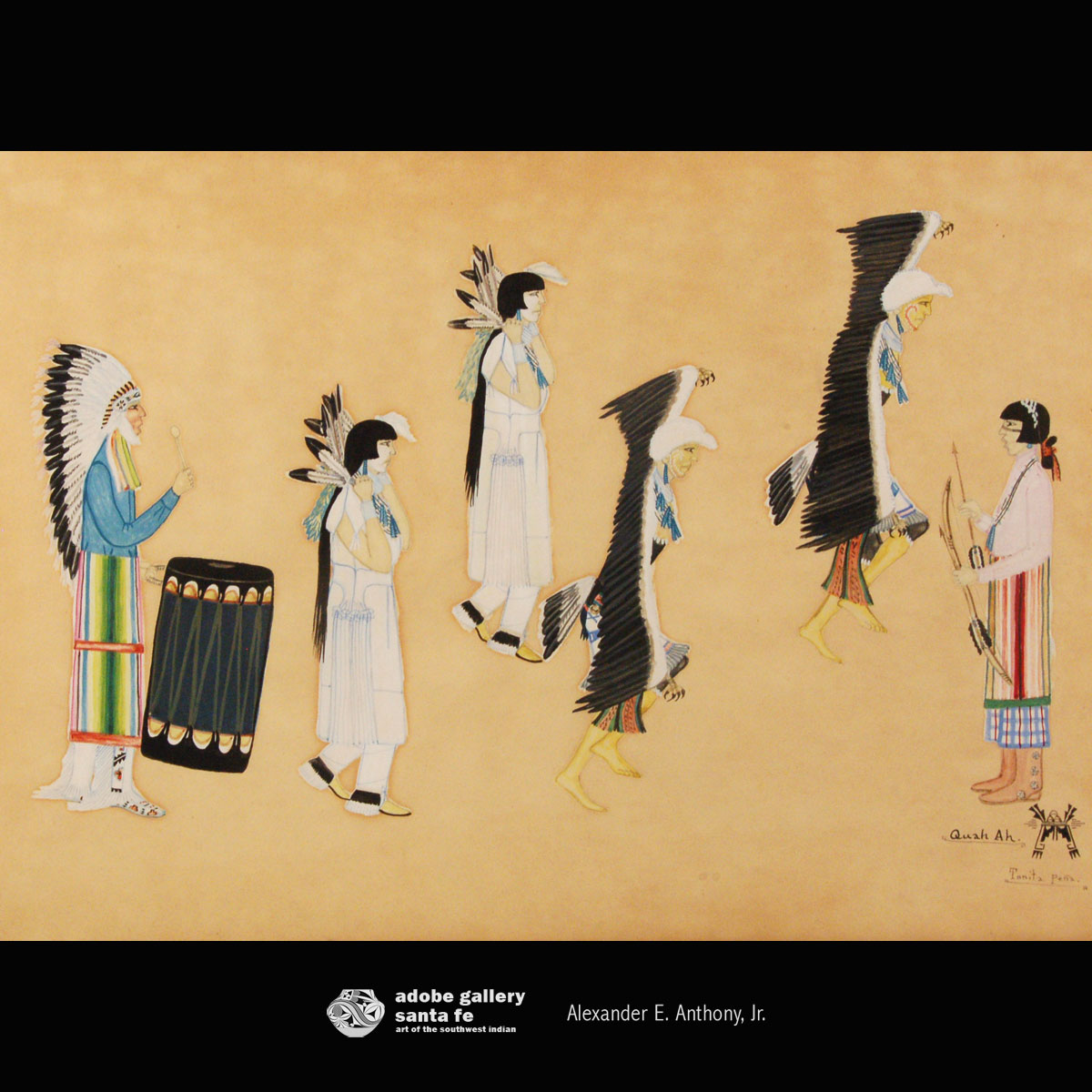 Tonita Peña (1893-1949) Quah Ah was born in 1893 at the small New Mexico pueblo of San Ildefonso. The pueblo is located on the Rio Grande, just north of Santa Fe. When Peña was just twelve years old, her mother passed away. Her father, unable to raise her while tending to his responsibilities at the pueblo, took her to live with her aunt and uncle at Cochiti Pueblo. This was where she would spend the remainder of her life. Tonita was the only woman in the group of talented early pueblo artists referred to as The San Ildefonso Self-Taught Group, which included such noted artists as Julian Martinez, Alfonso Roybal, Abel Sanchez, Crecencio Martinez, and Encarnación Peña. These artists were the earliest known pueblo painters. Today, their works are highly collectible not just because of their historical significance but because of their quality.
Tonita Peña (1893-1949) Quah Ah was born in 1893 at the small New Mexico pueblo of San Ildefonso. The pueblo is located on the Rio Grande, just north of Santa Fe. When Peña was just twelve years old, her mother passed away. Her father, unable to raise her while tending to his responsibilities at the pueblo, took her to live with her aunt and uncle at Cochiti Pueblo. This was where she would spend the remainder of her life. Tonita was the only woman in the group of talented early pueblo artists referred to as The San Ildefonso Self-Taught Group, which included such noted artists as Julian Martinez, Alfonso Roybal, Abel Sanchez, Crecencio Martinez, and Encarnación Peña. These artists were the earliest known pueblo painters. Today, their works are highly collectible not just because of their historical significance but because of their quality.
#adobegallery #SouthwestIndianPainting #NativeAmericanPainting #SanIldefonsoPainting #TonitaPena #FineArt #IndianMarketCountdown2018 #NativeAmericanArts
San Ildefonso Pueblo Painting of a Comanche Dance by Gilbert Atencio - C4084D
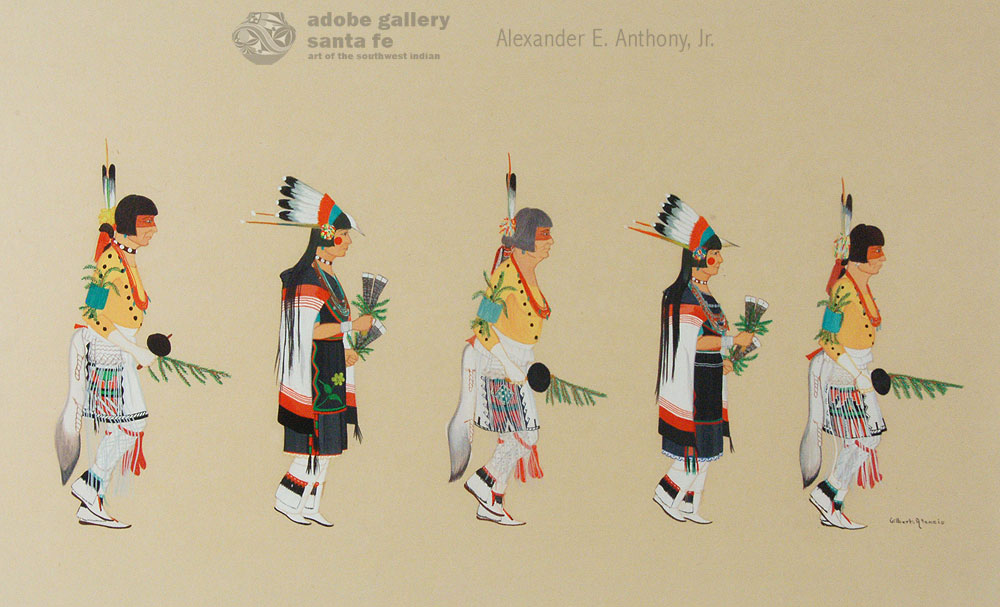 Gilbert Atencio (Wah Peen) was born in 1930 in Greeley, Colorado and died in April of 1995. He was the son of Isabel M. Montoya and the nephew of Maria Martinez. He was educated at San Ildefonso Day School and graduated from the Santa Fe Indian School in 1947. He served in the U.S. Marine Corp and lived most of his life in Santa Fe, New Mexico. Much of his inspiration for paintings came from stories his aunts told him about their lives. His style varied from the traditional "flat style" done early in his career, to abstract or semi-abstract paintings done in the 1980s. He was a medical and technical illustrator, too, working for Los Alamos National Laboratories.
Gilbert Atencio (Wah Peen) was born in 1930 in Greeley, Colorado and died in April of 1995. He was the son of Isabel M. Montoya and the nephew of Maria Martinez. He was educated at San Ildefonso Day School and graduated from the Santa Fe Indian School in 1947. He served in the U.S. Marine Corp and lived most of his life in Santa Fe, New Mexico. Much of his inspiration for paintings came from stories his aunts told him about their lives. His style varied from the traditional "flat style" done early in his career, to abstract or semi-abstract paintings done in the 1980s. He was a medical and technical illustrator, too, working for Los Alamos National Laboratories.
Towards the end of his life Atencio said about his work: "I do my paintings both for myself and for other people, especially for people who enjoy Indians, their way of life, their ceremonies. The people who buy my paintings are that type of people. They know some history of the Pueblo Indians. I do it for myself and for them. For the non-Indians who buy my work, I do it so they will appreciate Indian art and understand the Pueblo Indians-for more understanding between non-Indians and Indian life. If they come into the pueblo and if they have a painting of a certain dance, they known that what I have painted is the old version, and what they are seeing now-even though the young girls have cut their hair-is still the same dance. And so, appreciate the dance. Have respect for the way." (Wyckoff, p. 66)
#adobegallery #SouthwestIndianPainting #NativeAmericanPainting #SanIldefonsoPainting #GilbertAtencio #FineArt #IndianMarketCountdown2018 #NativeAmericanArts
San Ildefonso Painting of a Pueblo Deer Dancer by Julián Martinez - C4084K
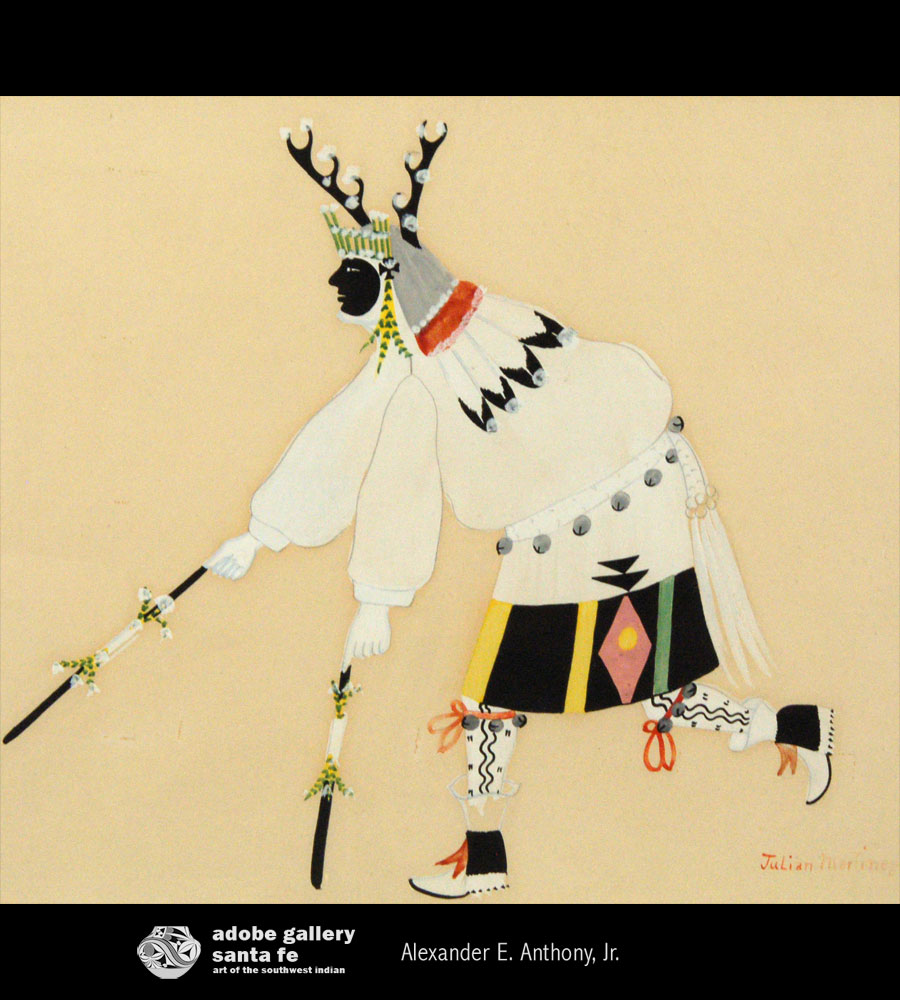 Julián Martinez (1885-1943) Pocano - Coming of the Spirits was an artist who was born, lived most of his life, and died at the small but artistically rich San Ildefonso Pueblo. He is perhaps best known for painting designs onto the pottery vessels created by his wife-the famous San Ildefonso potter Maria Martinez. He painted works on paper, too, and did so successfully despite receiving no formal art education. He was the father of Popovi Da and the grandfather of Tony Da, both of whom went on to become famous and successful artists themselves. Martinez was an important part of two major artistic movements: the beginnings of both black-on-black San Ildefonso pottery and traditional "flat style" pueblo painting.
Julián Martinez (1885-1943) Pocano - Coming of the Spirits was an artist who was born, lived most of his life, and died at the small but artistically rich San Ildefonso Pueblo. He is perhaps best known for painting designs onto the pottery vessels created by his wife-the famous San Ildefonso potter Maria Martinez. He painted works on paper, too, and did so successfully despite receiving no formal art education. He was the father of Popovi Da and the grandfather of Tony Da, both of whom went on to become famous and successful artists themselves. Martinez was an important part of two major artistic movements: the beginnings of both black-on-black San Ildefonso pottery and traditional "flat style" pueblo painting.
His works on paper are considered most rare, simply because he didn't have time very much to paint. Besides painter and pottery designer, his various occupations included farmer, laborer, Museum of New Mexico janitor, and Governor of San Ildefonso Pueblo. According to Jeanne Snodgrass' American Indian Painters: A Biographical Directory, Martinez began painting around 1920. He mostly painted traditional pueblo "flat style" depictions of pueblo dancers, but occasionally strayed away from tradition and towards abstract symbolism. Martinez' paintings were among those selected by Mary Jane Colter to decorate La Fonda Hotel in Santa Fe, New Mexico. He received several commissions for murals, which can be seen at the Santa Fe Indian School; Mesa Verde National Park, Colorado; and the School for Advaced Research in Santa Fe.
#adobegallery #SouthwestIndianPainting #NativeAmericanPainting #SanIldefonsoPainting #JulianMartinez #FineArt #IndianMarketCountdown2018 #NativeAmericanArts
San Ildefonso Painting of a Warrior on Horseback by Julián Martinez - C4084B
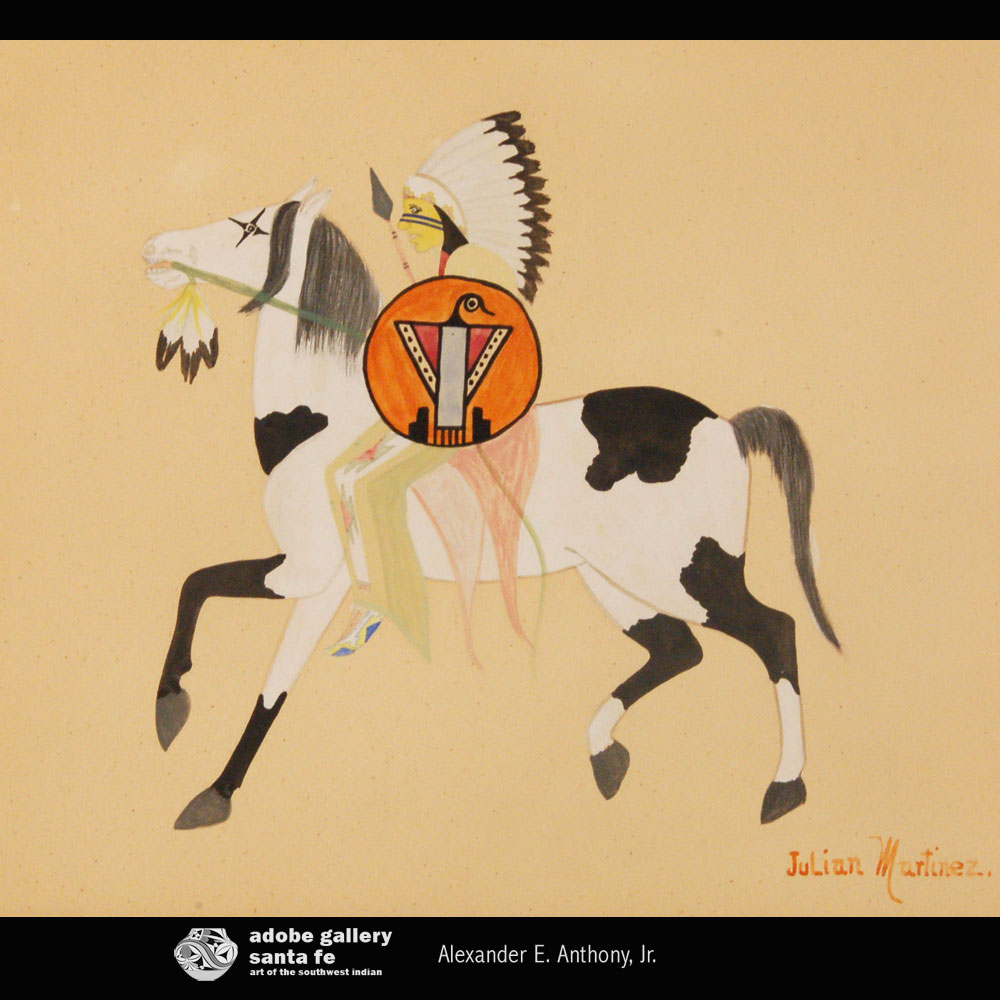 Julián Martinez (1885-1943) Pocano - Coming of the Spirits was an artist who was born, lived most of his life, and died at the small but artistically rich San Ildefonso Pueblo. He is perhaps best known for painting designs onto the pottery vessels created by his wife-the famous San Ildefonso potter Maria Martinez. He painted works on paper, too, and did so successfully despite receiving no formal art education. He was the father of Popovi Da and the grandfather of Tony Da, both of whom went on to become famous and successful artists themselves. Martinez was an important part of two major artistic movements: the beginnings of both black-on-black San Ildefonso pottery and traditional "flat style" pueblo painting.
Julián Martinez (1885-1943) Pocano - Coming of the Spirits was an artist who was born, lived most of his life, and died at the small but artistically rich San Ildefonso Pueblo. He is perhaps best known for painting designs onto the pottery vessels created by his wife-the famous San Ildefonso potter Maria Martinez. He painted works on paper, too, and did so successfully despite receiving no formal art education. He was the father of Popovi Da and the grandfather of Tony Da, both of whom went on to become famous and successful artists themselves. Martinez was an important part of two major artistic movements: the beginnings of both black-on-black San Ildefonso pottery and traditional "flat style" pueblo painting.
His works on paper are considered most rare, simply because he didn't have time very much to paint. Besides painter and pottery designer, his various occupations included farmer, laborer, Museum of New Mexico janitor, and Governor of San Ildefonso Pueblo. According to Jeanne Snodgrass' American Indian Painters: A Biographical Directory, Martinez began painting around 1920. He mostly painted traditional pueblo "flat style" depictions of pueblo dancers, but occasionally strayed away from tradition and towards abstract symbolism. Martinez's paintings were among those selected by Mary Jane Colter to decorate La Fonda Hotel in Santa Fe, New Mexico. He received several commissions for murals, which can be seen at the Santa Fe Indian School; Mesa Verde National Park, Colorado; and the School for Advanced Research in Santa Fe.
#adobegallery #SouthwestIndianPainting #NativeAmericanPainting #SanIldefonsoPainting #JulianMartinez #FineArt #IndianMarketCountdown2018 #NativeAmericanArts
San Ildefonso Painting of Pueblo Thunderbird by Julián Martinez - C4084L
 Julián Martinez (1885-1943) Pocano - Coming of the Spirits was an artist who was born, lived most of his life, and died at the small but artistically rich San Ildefonso Pueblo. He is perhaps best known for painting designs onto the pottery vessels created by his wife-the famous San Ildefonso potter Maria Martinez. He painted works on paper, too, and did so successfully despite receiving no formal art education. He was the father of Popovi Da and the grandfather of Tony Da, both of whom went on to become famous and successful artists themselves. Martinez was an important part of two major artistic movements: the beginnings of both black-on-black San Ildefonso pottery and traditional "flat style" pueblo painting.
Julián Martinez (1885-1943) Pocano - Coming of the Spirits was an artist who was born, lived most of his life, and died at the small but artistically rich San Ildefonso Pueblo. He is perhaps best known for painting designs onto the pottery vessels created by his wife-the famous San Ildefonso potter Maria Martinez. He painted works on paper, too, and did so successfully despite receiving no formal art education. He was the father of Popovi Da and the grandfather of Tony Da, both of whom went on to become famous and successful artists themselves. Martinez was an important part of two major artistic movements: the beginnings of both black-on-black San Ildefonso pottery and traditional "flat style" pueblo painting.
His works on paper are considered most rare, simply because he didn't have time very much to paint. Besides painter and pottery designer, his various occupations included farmer, laborer, Museum of New Mexico janitor, and Governor of San Ildefonso Pueblo. According to Jeanne Snodgrass' American Indian Painters: A Biographical Directory, Martinez began painting around 1920. He mostly painted traditional pueblo "flat style" depictions of pueblo dancers, but occasionally strayed away from tradition and towards abstract symbolism. Martinez' paintings were among those selected by Mary Jane Colter to decorate La Fonda Hotel in Santa Fe, New Mexico. He received several commissions for murals, which can be seen at the Santa Fe Indian School; Mesa Verde National Park, Colorado; and the School for Advaced Research in Santa Fe.
#adobegallery #SouthwestIndianPainting #NativeAmericanPainting #SanIldefonsoPainting #JulianMartinez #FineArt #IndianMarketCountdown2018 #NativeAmericanArts
Acoma Pueblo Black on White Design Jar by Mary Histia - C4068P
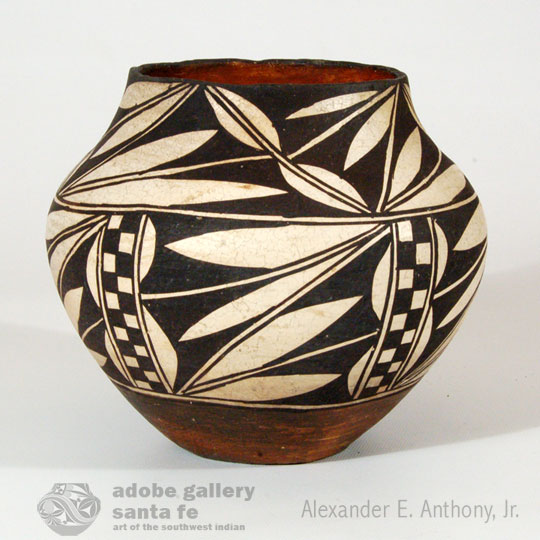 The black on white design on this jar has previously been identified as a design by Mary Histia. The vessel thinness is consistent with known examples of Histia's work and the preciseness of the painted design certainly follows her known quality of work. It appears safe to say that this unsigned jar was made by Mary Histia of Acoma, probably in the mid-twentieth century.
The black on white design on this jar has previously been identified as a design by Mary Histia. The vessel thinness is consistent with known examples of Histia's work and the preciseness of the painted design certainly follows her known quality of work. It appears safe to say that this unsigned jar was made by Mary Histia of Acoma, probably in the mid-twentieth century.
#adobegallery #SouthwestIndianPottery #AcomaPueblo #AcomaPottery #PuebloPottery #SouthwestIndianArt #MaryHistia #FinePuebloPottery #HistoricPottery #IndianMarketCountdown2018 #NativeAmericanArts
Original Painting of Navajo Man on Horseback by Narciso Abeyta - C4093
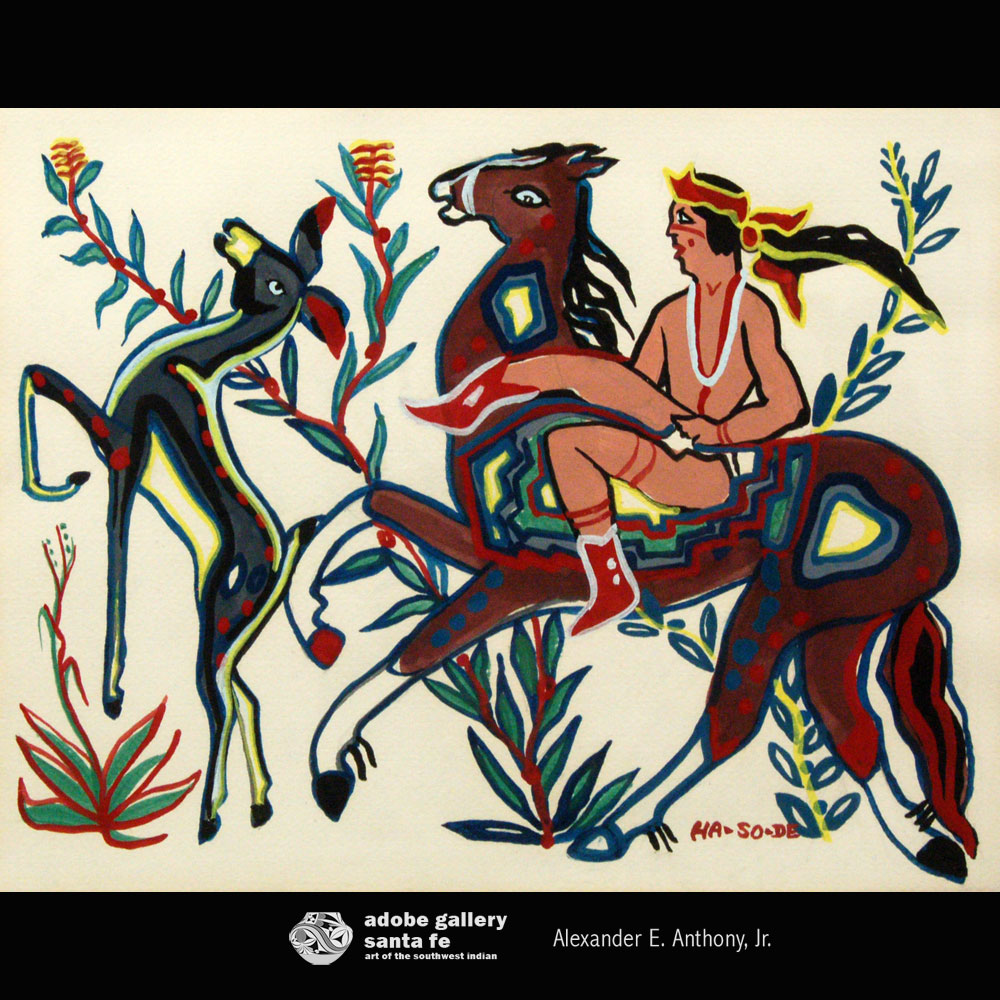 Narciso Platero Abeyta (1918-1998) Ha So De - Fiercely Ascending was a Diné painter and silversmith. He was, among other things, a Golden Gloves boxer and one of the hundreds of Navajo Code Talkers who served in the Marines during World War II. He and wife Sylvia Ann had seven children, many of whom-Tony Abeyta and Elizabeth Abeyta Rohrscheib and Pablita Abeyta-became notable artists themselves. He is highly revered by collectors of Native American art, and his works are included in numerous prestigious public and private collections. Because of his singular style, his enormously talented children, and his influence on younger painters, he is regarded as one of the most significant Native American painters.
Narciso Platero Abeyta (1918-1998) Ha So De - Fiercely Ascending was a Diné painter and silversmith. He was, among other things, a Golden Gloves boxer and one of the hundreds of Navajo Code Talkers who served in the Marines during World War II. He and wife Sylvia Ann had seven children, many of whom-Tony Abeyta and Elizabeth Abeyta Rohrscheib and Pablita Abeyta-became notable artists themselves. He is highly revered by collectors of Native American art, and his works are included in numerous prestigious public and private collections. Because of his singular style, his enormously talented children, and his influence on younger painters, he is regarded as one of the most significant Native American painters.
#adobegallery #SouthwestIndianPainting #NativeAmericanPainting #Navajo #Diné #FineArt #Painting #IndianMarketCountdown2018 #NativeAmericanArts #NarcisoAbeyta

